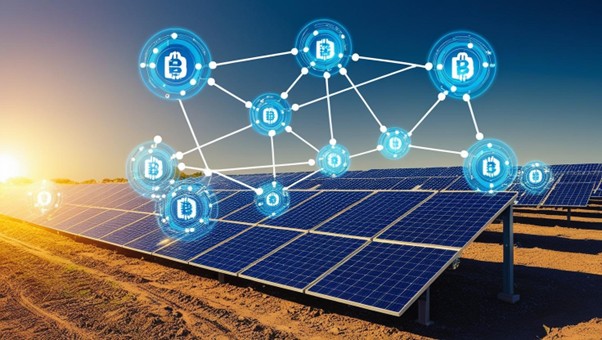The Role of Blockchain in Peer-to-Peer Solar Energy Trading
As the world pivots toward cleaner and more decentralized sources of energy, solar power has emerged as a leading solution in the fight against climate change. However, traditional energy distribution systems—centralized, monopolized, and often inefficient—do not fully align with solar energy’s decentralized nature. In this evolving landscape, blockchain technology is revolutionizing how solar energy is traded, especially in peer-to-peer (P2P) networks, making energy systems more democratic, secure, and transparent.
The Challenge with Traditional Energy Systems

In most countries, electricity is generated at large power plants and distributed through a centralized grid controlled by a few utility companies. Even if a household installs solar panels and generates excess energy, selling that surplus back to the grid is often limited, bureaucratic, or economically unfeasible. Consumers have minimal control over how they buy, sell, or trade energy.
Moreover, central systems are prone to single points of failure, lack transparency, and often come with high transaction or operational costs. These constraints make it difficult for small producers—like individual households with solar panels—to participate actively in the energy market.
This is where blockchain steps in.
What is Blockchain?

Blockchain is a distributed ledger technology that records transactions in a secure, immutable, and transparent manner across a decentralized network. Once data is added to the blockchain, it cannot be altered or deleted, ensuring the integrity and traceability of each transaction.
In the context of solar energy trading, blockchain can eliminate the need for intermediaries, create trust between unknown parties, and enable real-time, automated transactions via smart contracts.
Peer-to-Peer Solar Trading: How It Works

Imagine a neighborhood where several homes have solar panels. Some produce more electricity than they need, while others still draw power from the grid. With a blockchain-based P2P energy trading platform, producers can sell their excess solar energy directly to neighbors who need it—without relying on utility companies.
Each unit of energy generated is tokenized and recorded on the blockchain. Using smart meters and smart contracts, the system automatically tracks generation, consumption, pricing, and payments. Transactions occur seamlessly, with all participants having real-time access to energy data and market rates.
Here’s a simplified example:
- Home A generates 10 extra kWh of solar energy.
- Home B needs 5 kWh and agrees to pay a fair market price.
- A smart contract is triggered: the blockchain verifies the availability, completes the transaction, transfers the tokens (representing energy), and updates the ledger.
Benefits of Blockchain in P2P Solar Trading

1. Decentralization and Democratization
Blockchain enables decentralization, allowing anyone with solar panels to become a producer and seller of energy. It removes gatekeepers and gives communities direct control over their energy transactions.
2. Transparency and Trust
All transactions are publicly recorded on the blockchain, ensuring transparency. Consumers can trust that they’re getting what they pay for, and producers are assured of payment.
3. Security and Tamper-Proof Records
Blockchain’s cryptographic security ensures that transaction data is immutable and safe from tampering. This is crucial for billing, energy credits, and dispute resolution.
4. Lower Costs
Eliminating intermediaries and automating transactions via smart contracts reduces administrative overhead and transaction fees.
5. Real-Time Trading
With IoT-enabled smart meters and blockchain integration, energy trading becomes dynamic and real-time, adjusting instantly based on supply and demand.
Real-World Examples

Several pilot projects around the world are already showcasing the potential of blockchain in P2P energy trading:
- Power Ledger (Australia): One of the pioneers in this space, Power Ledger allows households to trade excess solar power using blockchain. Their platform has been adopted in multiple countries, including India and the U.S.
- Brooklyn Microgrid (USA): A project by LO3 Energy, the Brooklyn Microgrid lets residents generate and trade solar energy locally using blockchain, fostering community-driven energy markets.
- EDF & Electron (UK): Energy giant EDF is experimenting with blockchain through partnerships with startups like Electron to enable flexible trading and decentralized grid services.
Challenges and the Road Ahead

While promising, blockchain-based P2P energy trading still faces several challenges:
- Regulatory Hurdles: Most countries have strict regulations around energy trading, which can hinder the implementation of decentralized systems.
- Infrastructure Requirements: Smart meters, IoT devices, and internet access are prerequisites, which might be limited in rural or underdeveloped areas.
- Scalability: Blockchain platforms must scale efficiently to handle a large number of transactions without compromising speed or cost.
- Public Awareness: For P2P trading to become mainstream, consumers need education about the benefits and workings of blockchain energy systems.
Conclusion
Blockchain is not just a buzzword—it is an enabling technology that can reshape how we produce, consume, and trade energy. By allowing secure, transparent, and decentralized transactions, blockchain empowers everyday citizens to participate actively in the energy ecosystem.
Peer-to-peer solar energy trading through blockchain has the potential to make energy cleaner, cheaper, and more accessible. As more countries embrace decentralized energy models and smart infrastructure, blockchain could become the backbone of the next-generation energy grid—one that is local, resilient, and inclusive.
References:
https://www.sciencedirect.com/science/article/abs/pii/S0045790621002780



